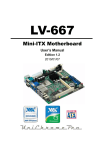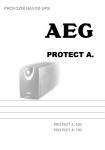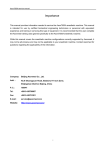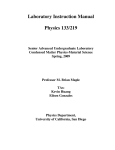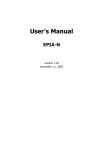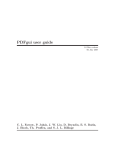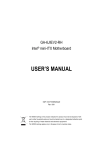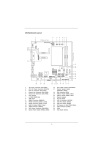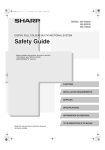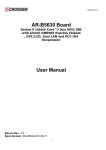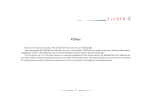Download ACE-B8700 Board User Manual
Transcript
Revision: 1.0
ACE-B8700 Board
PCI I/O Board with discrete I/O, battery backup SRAM,
Timer, Power-off intrusion Event Logger and Protect-U
User Manual
Manual Rev.: 1.0
Book Number: ACE-B8700-2010.03.01
1
Revision: 1.0
Revision
Version
1.0
Date
Author
2010/03/01 Kenny Lee
Description
Initial release
2
Revision: 1.0
Copyright 2010
All Rights Reserved.
Manual’s first edition: February 09, 2010
For the purpose of improving reliability, design and function, the information in this
document is subject to change without prior notice and does not represent a commitment
on the part of the manufacturer.
In no event will the manufacturer be liable for direct, indirect, special, incidental, or
consequential damages arising out of the use or inability to use the product or
documentation, even if advised of the possibility of such damages.
This document contains proprietary information protected by copyright. All rights are
reserved. No part of this Manual may be reproduced by any mechanical, electronic, or
other means in any form without prior written permission of the manufacturer.
Trademarks
ACE-B8700 is a registered trademarks of Acrosser; IBM PC is a registered
trademark of the International Business Machines Corporation; Pentium is a registered
trademark of Intel Technologies Inc; Award is a registered trademark of Award Software
International Inc; other product names mentioned herein are used for identification
purposes only and may be trademarks and/or registered trademarks of their respective
companies.
3
Revision: 1.0
Table of Contents
1 Introduction.............................................................................. 5
1.1 Specifications .................................................................................. 6
1.2 Package Contents ........................................................................... 6
1.3 Block Diagram ................................................................................. 7
2 H/W Information ....................................................................... 8
2.1 Locations (Top Side) ....................................................................... 8
2.2 Connector and Jumper Setting ...................................................... 9
2.3 Connector and Jumper Setting Table .......................................... 11
3 BIos Setting............................................................................ 14
3.1 Main Setup ..................................................................................... 15
3.2 Advanced Chipset Setup .............................................................. 16
3.3 PnP/PCI setup................................................................................ 17
3.4 Peripherals Setup .......................................................................... 18
3.5 AGC Setup ..................................................................................... 19
3.6 Boot setup ..................................................................................... 20
3.7 Exit Setup ...................................................................................... 21
4 AGC Register Description .................................................... 23
4.1 PCI Configuration Register........................................................... 23
4.2 SRAM Memory Address Map ........................................................ 28
4.3 I/O-Interface Address Map ............................................................ 29
5 Electrical Characteristics ..................................................... 37
5.1 Basic Electrical Characteristics Table ......................................... 37
5.2 72 Pins Golden Finger .................................................................. 38
5.3 20 Pins Golden Finger .................................................................. 39
5.4 AGC Port Assignment ................................................................... 40
Notes .................................................................................................... 42
4
Revision: 1.0
1
INTRODUCTION
Welcome to the ACE-B8700 Computer. The ACE-B8700 is an All-in-One gaming
board integrated a VIA VX800 industrial computer with Acrosser's gaming controller.
This gaming controller features digital input, digital output, SRAM, timer, intrusion logger,
secured real time clock and security ID. Together with the software development kit
(SDK), ACE-B8700 is very easy to control devices in a gaming machine. Please refer to
following specification for detail functions.
5
Revision: 1.0
1.1 Specifications
VIA C7 1.5GHz processor, VX800 chipset.
3D core support DX9
VIA PadLock engine: AES, RNG, Security Hash
Optional on board 512MB DDR2 memory
VGA DB15 output + optional secondary VGA
Digital Input: 25 x optical isolated and 5 TTL level input for door switch with intrusion
logger
Digital Output: 25x 500mA , 2 x 1000mA
4 x 16-bit Interruptible Timer
4 x RS-232 serial ports
72-pin golden finger interface
ProtectU and Optional iButton socket for software security
Single 256KB battery back-up SRAM with battery low monitor for each battery
Secondary real time clock
One 8-bit readable DIP switch
6 watts Stereo amplifier
1.2 Package Contents
Check if the following items are included in the package.
Quick Manual
ACE-B8700 board
1 x Software Utility CD
6
Revision: 1.0
1.3 Block Diagram
C7 nano
BGA
DDRII DIMM X 1
DDRII 512MB onboard
CRT1
AGA
VX800
SATAX2
COM PORT*2
CFX1
CRT2
VT1625
USB Port X4
LPC BUS
PCI BUS
SPI
AGC
EtherNET
10/100M
RJ-45
SPI ROM
X1
HD Link
HD CODEC
7
6W A
class
AMP
Fintek
COM
PORT*4
Revision: 1.0
2
H/W INFORMATION
This chapter describes the installation of ACE-B8700. At first, it shows the Function
diagram and the layout of ACE-B8700. It then describes the unpacking information which
you should read carefully, as well as the jumper/switch settings for the ACE-B8700
configuration.
2.1 Locations (Top Side)
USB1
One RJ45 with two layer USB
connector
DIMM1
DDR2 SODIMM socket
SATA1 & SATA2
Standard 7-pin SATA
connector
CF1
Standard CF Card Slot
72 Pins Golden Fingers
General Gaming interface
U73
iButton holder
U6
Chipset VIA VX800
VGA1
D-Sub 15-pin VGA
connector
U2
Processor VIA C7 1.5G
COM1_2 & COM3_4
Dual D-Sub 9-pin RS232
connector
20 Pins Golden Fingers
Work with 72 Pins Golden
Fingers
BAT1
CR2032 Size Coin Battery
BAT2
CR2032 Size Coin Battery for
AGA/SRAMA
8
Revision: 1.0
2.2 Connector and Jumper Setting
2.2.1 Locations (Top side)
9
Revision: 1.0
2.2.2 List of Connector and Jumper Setting
CCTALK1
JST connector for ccTalk
(Signal share with
COM6).
CN4
JST connector for Case
Open Intrusion logger.
KM1
JST connector for Keyboard
and Mouse.
SW1
8-bit readable DIP switch.
CN3
Pin header for 2 USB ports.
COM6(optional)
Pin header for RS232 port.
JPC_2
Bill enable, Coin enable and
Hopper pre-set pin header.
JBAT3
SRAM A and SRAM B supply
voltage select from BAT2 or
BAT3 pin header.
JSRAMA & JSRAMB
SRAM A and SRAM B data
clear pin header.
BAT3(optional)
Rechargeable Battery for
SRAM A and SRAM B.
VR1 & VR2
Adjust audio volume.
JPB_1
Select Audio output
with/without amplifier pin
header.
JPB_2
Select SPEAKER RIGHT+
connect to 72 Pins Golden
Fingers (B4, B5) or (A2, B2).
AUDIO1
JST connector for Audio
output.
COM3_4
RS232/ccTalk/RS485 output.
LED1
LED for Power & HDD.
SATAPWR1
JST connector for SATA
power.
JP20
Reset pin header.
VGA2(optional)
Secondary VGA.
FAN1
CPU Fan Connector.
JPA_1 & JPA_2
Select COM1 or COM2 is
RS232 or TTL.
JPA_3
Select COM3 is RS232 or
ccTalk.
JPA_5
Select COM4 is RS232 or
RS485.
JPA_4
Select COM3 is RS232 or
ccTalk.
JPA_6
Select COM4 is RS232 or
RS485.
JPA_7
Select COM6 is RS232 or
ccTalk.
JP11
CF Card master/slave
select pin header.
JP13
CF Card Voltage select
pin header.
JBAT1
CMOS clear pin header.
10
Revision: 1.0
2.3 Connector and Jumper Setting Table
1. CCTALK1
Pin
1
2
3
4
2. KM1
3. SW1
Pin
1
2
3
4
5
6
Signal
DATA
COM
NC
12V
4. CN4
Signal
Mouse data
Keyboard data
GND
5V
Mouse clock
Keyboard clock
5. CN3
Pin
1
2
7. JP11/JP13
Pin
1-2
Open
1-2
Close
Signal
5V
-USB0
+USB0
GND
NC
Pin
2
4
6
8
10
Pin
Slave
Master
Status
Open
1-2
(default)
Close
(default)
3-4
JP13
Setting
Close
(default)
Open
5V
Close
2-3
5-6
Close
3.3V
(default)
Close
Pin
1
3
5
7
9
Signal
-DCD
SIN
SOUT
-DTR
GND
Pin
2
4
6
8
10
Signal
-DSR
-RTS
-CTS
-RI
NC
9. JBAT3/JSRAMA/JSRAMB
Open
Pin
1-2
Signal
5V
-USB2
+USB2
GND
GND
8. JPC_2
JP11
Setting
Signal
GND
3.3V
6. COM6
Pin
1
3
5
7
9
Signal
Case open
GND
Status
ON
OFF
(default)
11
Setting
Preset is
LOW
JSRAMA
Preset is
HIGH
Preset is
LOW
Preset is
HIGH
Preset is
LOW
Preset is
HIGH
JBAT3
Pin
1-2
Setting
BAT2
JSRAMB
Setting
Normal
close
2-3
(default)
(default)
BAT3
Clear
SRAM
close
Revision: 1.0
10. BAT3
11. VR1/VR2
12. JPB_1/JPB_2
Pin
Pin
1
2
Signal
GND
3.3V
1-3,
2-4
close
Adjust volume level by turning VR
clockwise
Pin
1
2
3
4
14. COM3_4
Signal
SPEAKER
RIGHT+
GND
SPEAKER
LEFT+
GND
16. SATAPWR1
Pin
1
2
3
4
Pin
1
2
3
4
5
6
7
8
9
Signal
12V
GND
3.3V
5V
Audio
Out
with
Amplifier
JPB_2
Setting
SPEAKER
RIGHT+
connect to 72
Pins Golden
Fingers(B5,
B4)
(default)
3-5,
4-6
close
13. AUDIO1
JPB_1
Setting
Audio
Out
without
Amplifier
(default)
SPEAKER
RIGHT+
connect to 72
Pins Golden
Fingers(A2,
B2)
15. LED1
RS232
-DCD
SIN
SOUT
-DTR
GND
-DSR
-RTS
-CTS
-RI
COM3
ccTalk
12V
Data
GND
-
17. JP20
COM4
RS485
Data+
Data-
LED
Green
Red
Signal
HDD
Power
Signal
RED
GREEN
BLUE
VSYNC
HSYNC
Pin
2
4
6
8
10
18. VGA2
Pin
1
2
Signal
Reset
GND
12
Pin
1
3
5
7
9
Signal
GND
GND
GND
SCL
SDA
Revision: 1.0
19. FAN1
20. JPA_1/JPA_2/JPA_3/JPA_5
Pin
1
2
3
Pin
1-2, 4-5, 7-8, 10-11,
13-14, 16-17, 19-20,
22-23 Close
2-3, 5-6, 8-9, 11-12,
14-15, 17-18, 20-21,
23-24 Close
Signal
GND
12V
NC
21. JPA_4/JPA_6/JPA_7
Pin
1-3, 2-4
Close
3-5, 4-6
Close
JPA_1 &
JPA_2
Setting
JPA_3
JPA_5
Setting
Setting
TTL
Output
ccTalk
output
RS485
output
RS232 output
(default)
RS232 output
(default)
RS232 output
(default)
22. JBAT1
JPA_4
Setting
JPA_6
Setting
JPA_7
Setting
RS232 (default)
RS232 (default)
RS232
ccTalk
RS485
ccTalk (default)
13
Pin
1-2
Close
2-3
Close
Setting
Normal (default)
Clear COMS
Revision: 1.0
3
BIOS SETTING
This chapter describes the BIOS menu displays and explains how to perform
common tasks needed to get the system up and running. It also gives detailed
explanation of the elements found in each of the BIOS menus. The following topics are
covered:
Main Setup
Advanced Chipset Setup
Peripherals Setup
PnP/PCI Setup
AGC Setup
Boot Setup
Exit Setup
14
Revision: 1.0
3.1 Main Setup
Once you enter the Award BIOS™ CMOS Setup Utility, the Main Menu will appear
on the screen. Use the arrow keys to highlight the item and then use the <Pg Up> <Pg
Dn> keys to select the value you want in each item.
Note: Listed at the bottom of the menu are the control keys. If you need any help with the
item fields, you can press the <F1> key, and it will display the relevant information.
Option
Choice
Description
Date Setup
N/A
Set the system date. Note that the ‘Day’ automatically
changes when you set the date
Time Setup
N/A
Set the system time
IDE Channel 0
Master/Slave
N/A
The onboard PCI IDE connectors provide 1 channel for
connecting up to 2 IDE hard disks or other devices. The first
is the “Master” and the second is “Slave”, BIOS will
auto-detect the IDE type.
Halt On
All Errors,
No Errors,
All but keyboard.
Select the situation in which you want the BIOS to stop the
POST process and notify you.
15
Revision: 1.0
3.2 Advanced Chipset Setup
Option
Choice
Description
Quick Power On Self
Test
Enabled
Disabled
This category speeds up Power On Self Test (POST) after you
have powered up the computer. If it is set to Enable, BIOS will
shorten or skip some check items during POST.
Full Screen Logo
Show
Enabled
Disabled
Select Enabled to show the OEM full screen logo if you have
add-in BIOS.
VGA Share Memory
Size
64M
128M
256M
Boot Display
CRT
CRT+CRT2
This Item is for setting the Frame Buffer (Share system memory
as display memory).
This Item is to set display device
16
Revision: 1.0
3.3 PnP/PCI setup
Option
Choice
Description
Enabled
Disabled
Normally, you leave this field Disabled. Select Enabled to
reset Extended System Configuration Data (ESCD) when you
exit Setup. If you have installed a new add-on and the system
reconfiguration has caused such a serious conflict, then the
operating system cannot boot.
Resources
Controlled By
Auto(ESCD)
Manual
The Award Plug and Play BIOS has the capacity to
automatically configure all of the boot and Plug and Play
compatible devices. However, this capability means absolutely
nothing unless you are using a Plug and Play operating
system such as Windows 95. If you set this field to “manual,”
then you may choose specific resources by going into each of
the submenus.
IRQ Resources
N/A
Reset Configuration
Data
When resources are controlled manually, assign a type to
each system interrupt, depending on the type of the device
that uses the interrupt
17
Revision: 1.0
3.4 Peripherals Setup
Option
Onboard Serial Port 1
Onboard Serial Port 2
Onboar`d Serial Port 3
Onboard Serial Port 4
Onboard Serial Port 5
Onboard Serial Port 6
Choice
Serial Port 1: 3F8 / IRQ11
Serial Port 2: 2F8 / IRQ10
Serial Port 3: 2A8 / IRQ7
Serial Port 4: 288 / IRQ5
Serial Port 5: 3E8 / IRQ4
Serial Port 6: 2E8 / IRQ3
Select an address and the corresponding
interrupt for each serial port.
The integrated peripheral controller
contains an IDE interface with support for
two IDE channels. Select Enabled to
activate each channel separately.
On chip IDE DEVICE
USB Device Setting
Description
Select Enabled if your system contains
a Universal Serial Bus (USB) 2.0
controller and you have USB
peripherals
Enabled
Disabled
This item allows you to decide to
enable/disable AC97 Audio
OnChip PCI Device
18
Revision: 1.0
3.5 AGC Setup
Option
Choice
Description
Port-H I/O Mode Set
Output
Input
Port-H Status
00 to FF
Port-I I/O Mode Set
Output
Input
Port-I Status
00 to FF
If Port I I/O Mode is
User can modify it
Timer A/B/C/D Resolution.
us / ms / sec
For timer resolution
‘us’=microsecond
‘ms’=millisecond
‘sec’=second
De-bounce Time for Port
A
B
C
D
E
F
G
H
If Port H I/O Mode is
User can modify it
“Output” ,
“Output” ,
Select one of these Ports to set
De-bounce Time
Port A~H de-bounce Time
0-255
Setting de-bounce time for each
I/O port. The value 0 means that
the de-bounce time is 1 ms. The
default setting is 16 (i.e. 17 ms).
De-bounce Time for Port
I
J
Select one of these Ports to set
De-bounce Time
0-255
Setting de-bounce time for each
I/O port. The value 0 means that
the de-bounce time is 1 ms. The
default setting is 16 (i.e. 17 ms).
Port I/J de-bounce Time
19
Revision: 1.0
3.6 Boot setup
Option
First / Second / Third
Boot Device/Other Boot
Device
Hard Disk Boot Priority
Choice
Hard Disk
CDROM
USB-FDD
USB-CDROM
Disabled
Description
The BIOS attempts to load the operating
system from the devices in the sequence
selected in these items.
These fields set the Boot Priority for each
Hard Disk (SATA/IDE HDD and USB
Flash)
N/A
20
Revision: 1.0
3.7 Exit Setup
Option
Choice
Description
Pressing <Enter> on this item
for confirmation:
Save & Exit Setup
Save to CMOS and EXIT
(Y/N)? Y
Load Optimized Defaults
When you press <Enter> on
this item you get a
confirmation dialog box with a
message like this:
Press “Y” to store the selections made in
the menus in CMOS – a special section of
memory that stays on after you turn your
system off. The next time you boot your
computer, the BIOS configures your system
according to the Setup selections stored in
CMOS. After saving the values the system
is restarted again
Press ‘Y’ to load the default values that are
factory-set for optimal-performance system
operations.
Load Optimized Defaults
(Y/N)? N
Exit Without Saving
Pressing <Enter> on this item
for confirmation:
Quit without saving (Y/N)? Y
Set Password
Pressing <Enter> on this item
for confirmation:
ENTER PASSWORD:
This allows you to exit Setup without storing
any changes in CMOS. The previous
selections remain in effect. This shall exit
the Setup utility and restart your computer.
When a password has been enabled, you
will be prompted to enter your password
every time you try to enter Setup. This
prevents unauthorized persons from
changing any part of your system
configuration.
Type the password, up to eight characters
21
Revision: 1.0
in length, and press <Enter>. The password
typed now will clear any previous password
from the CMOS memory. You will be asked
to confirm the password. Type the
password again and press <Enter>. You
may also press <Esc> to abort the selection
and not enter a password.
To disable a password, just press <Enter>
when you are prompted to enter the
password. A message will confirm that the
password will be disabled. Once the
password is disabled, the system will boot
and you can enter Setup freely.
22
Revision: 1.0
4
AGC REGISTER DESCRIPTION
This chapter describes the function of the Register inside an AGC chip. To program the
application’s software, an user must have the know-how of these Registers.
4.1 PCI Configuration Register
PCI CFG
Register
Offset
Address
32 bit Register
31
24
23
16
15
8
7
0
PCI
Readable
PCI
Writable
00h
Device ID
Vendor ID
Yes
No
04h
Status
Command
08h
Class Code
Header Type
Latency Timer
Yes
No
Revision ID
Yes
No
Cache Line Size
Yes
No
0Ch
BIST
10h
PCI Base Address 0 for Memory Mapped Configuration Registers
Yes
Yes
14h
PCI Base Address 1 for I/O Mapped Configuration Registers
Yes
Yes
18h
PCI Base Address 2 (Not Supported)
No
No
1Ch
PCI Base Address 3 (Not Supported)
No
No
20h
PCI Base Address 4 (Not Supported)
No
No
24h
PCI Base Address 5 (Not Supported)
No
No
28h
Cardbus CIS Pointer (Not Supported)
Yes
No
2Ch
Subsystem Vendor ID
Yes
No
30h
PCI Base Address for Local Expansion ROM (Not Supported)
Yes
No
34h
Reserved
No
No
38h
Reserved
No
No
Yes
Yes / No
3Ch
Subsystem ID
Max_Lat
Min_Gnt
Interrupt Pin
Interrupt Line
Vendor ID Register (00h : 01h)
Bit Field
15 : 0
Description
Vendor ID. Identifies manufacturer of the device.
Software
Readable
Software
Writable
Value after
Reset
Yes
No
1204h
Software
Readable
Software
Writable
Value after
Reset
Yes
No
8700h
Device ID Register (02h : 03h)
Bit Field
31 : 16
Description
Device ID. Identifies particular device.
23
Revision: 1.0
Command Register (04h : 05h)
Bit Field
Description
Software
Readable
Software
Writable
Value after
Reset
0
I/O Space. Value of 1 allows device to respond to I/O space
accesses.
Yes
No
1
1
Memory Space. Value of 1 allows device to respond to
memory space accesses
Yes
No
1
2
Master Enable. Value of 0 disables device from generating
bus master accesses. Not Supported
Yes
No
0
3
Special Cycle. Not Supported.
Yes
No
0
4
Memory Write/Invalidate. Not Supported.
Yes
No
0
5
VGA Palette Snoop. Not Supported.
Yes
No
0
6
Parity Error Response. Not Supported.
Yes
No
0
7
Wait Cycle Control. Not Supported.
Yes
No
0
8
SERR# Enable. Not Supported.
Yes
No
0
9
15 : 10
Fast Back-to-Back Enable. Not Supported.
Yes
No
0
Reserved
Yes
No
0
Software
Readable
Software
Writable
Value after
Reset
Status Register (06h : 07h)
Bit Field
22 : 16
Description
Reserved
Yes
No
0
23
Fast Back-to-Back Capable. Not Supported.
Yes
No
0
24
Master Data Parity Error Detected. Not supported
Yes
No
0
26 : 25
DEVSEL Timing. Value of 01 is Slow.
Yes
No
10
27
Target Abort. 1 if Device has Signal Target Abort.
Yes
Yes
0
28
Received Target Abort. Not Supported.
Yes
No
0
29
Received Master Abort. Not Supported.
Yes
No
0
30
Signaled System Error. Not Supported.
Yes
No
0
31
Detected Parity Error. Not Supported.
Yes
No
0
Software
Readable
Software
Writable
Value after
Reset
Yes
No
15h
Software
Readable
Software
Writable
Value after
Reset
Revision ID Register (08h)
Bit Field
7:0
Description
Revision ID. Identifies particular device.
Class Code Register (09h : 0Bh)
Bit Field
Description
15 : 8
Specific Register Level Programming Interface (00h). No
interface defined.
Yes
No
00h
23 : 16
Subclass Encoding (80h). Other bridge device.
Yes
No
80h
31 : 24
Base Class Encoding. Other bridge Device.
Yes
No
06h
Software
Readable
Software
Writable
Value after
Reset
Cache Line Size Register (0Ch)
Bit Field
7:0
Description
System Cache Line Size (in units of 32-bit words). Can be
written and read; however, the value has no effect on
operation of chip.
Yes
No
0
Latency Timer Register (0Dh)
Bit Field
15 : 8
Description
PCI Latency Timer. Not Supported.
24
Software
Readable
Software
Writable
Value after
Reset
Yes
No
0
Revision: 1.0
Header Type Register (0Eh)
Software
Readable
Software
Writable
Value after
Reset
Configuration Layout Type. Specifies layout of bits 10h
through 3Fh in configuration space. Only one encoding 0 is
defined. All other encodings are reserved.
Yes
No
0
Header Type. Value of 1 indicates multiple functions. Value of
0 indicates a single
Function.
Yes
No
0
Bit Field
22 : 16
23
Description
Built-In Self Test Register (0Fh)
Bit Field
Description
Software
Readable
Software
Writable
Value after
Reset
31 : 24
Built-In Self Test. Value of 0 indicates that device has passed
its test. Not Supported.
Yes
No
0
Software
Readable
Software
Writable
Value after
Reset
Memory Space Indicator. Value of 0 indicates register maps
into Memory space. Value of 1 indicates register maps into
I/O space.
Yes
No
0
Location of register:
00 = Locate anywhere in 32 bit memory address space
01 = Locate below 1 MB memory address space
10 = Locate anywhere in 64 bit memory address space
11 = Reserved
Yes
No
0
Prefetchable. Value of 1 indicates no side effect on reads.
Yes
No
0
6:4
Memory Base Address. Memory base address for access to
local configuration registers (default 8 Kbytes).
Yes
No
0
31 : 7
Memory Base Address. Memory base address for access to
local configuration registers.
Yes
Yes
0
Software
Readable
Software
Writable
Value after
Reset
Base Address 0 Registers for Memory Accesses to Local Configuration (10h)
Bit Field
0
2:1
3
Description
Base Address 1 Register for I/O Accesses to Local Configuration (14h)
Bit Field
Description
0
Memory Space Indicator. Value of 0 indicates register maps
into Memory space. Value of 1 indicates register maps into
I/O space.
Yes
No
1
1
Reserved
Yes
No
0
6:2
I/O Base Address. Base address for I/O access to local
configuration registers (default 128 bytes).
Yes
No
0
31 : 7
I/O Base Address. Base address for I/O access to local
configuration registers
Yes
Yes
0
25
Revision: 1.0
Base Address 2 Registers (18h)
Bit Field
31 : 0
Description
Not Supported
Software
Readable
Software
Writable
Value after
Reset
Yes
No
0
Software
Readable
Software
Writable
Value after
Reset
Yes
No
0
Software
Readable
Software
Writable
Value after
Reset
Yes
No
0
Software
Readable
Software
Writable
Value after
Reset
Yes
No
0
Software
Readable
Software
Writable
Value after
Reset
Yes
No
0
Software
Readable
Software
Writable
Value after
Reset
Yes
Yes
00h
Software
Readable
Software
Writable
Value after
Reset
Yes
Yes
00h
Software
Readable
Software
Writable
Value after
Reset
Yes
No
0
Base Address 3 Registers (1Ch)
Bit Field
31 : 0
Description
Not Supported
Base Address 4 Registers (20h)
Bit Field
31 : 0
Description
Not Supported
Base Address 5 Registers (24h)
Bit Field
31 : 0
Description
Not Supported
Cardbus CIS Pointer Registers (28h)
Bit Field
31 : 0
Description
Card bus Information Structure Pointer for PCMCIA. Not
Supported.
Subsystem Vendor ID Registers (2Ch)
Bit Field
15 : 0
Description
Subsystem Vendor ID (Unique add-in board Vendor ID)
Subsystem ID Registers (2Eh)
Bit Field
31 : 16
Description
Subsystem ID. (Unique add-in board Device ID)
Base Address for Local Expansion ROM Registers (30h)
Bit Field
31 : 0
Description
Not Supported
Interrupt Line Registers (3Ch)
Bit Field
Description
Software
Readable
Software
Writable
Value after
Reset
7:0
Interrupt Line Routing Value indicates which system interrupt
controller(s) input the interrupt line of device is connected to.
Yes
Yes
0
26
Revision: 1.0
Interrupt Pin Registers (3Dh)
Bit Field
15 : 8
Description
Interrupt Pin Register indicates the interrupt pin that the
device uses. The following values are decoded:
0 = No Interrupt Pin
1 = INTA#
2 = INTB#
3 = INTC#
4 = INTD#
Note: supports only one PCI interrupt (INTA#).
Software
Readable
Software
Writable
Value after
Reset
Yes
No
1
Min Gnt Registers (3Eh)
Bit Field
Description
Software
Readable
Software
Writable
Value after
Reset
23 : 16
Min Gnt. Specifies needed length of Burst period for the
device, assuming a clock rate of 33 MHz. Value is a multiple
of 1/4 µs increments. Not Supported.
Yes
No
0
Max Lat Registers (3Fh)
Bit Field
Description
Software
Readable
Software
Writable
Value after
Reset
31 : 24
Max Lat. Specifies how often the device must gain access to
PCI bus. Value is a multiple of 1/4 µs increments. Not
Supported.
Yes
No
0
27
Revision: 1.0
4.2 SRAM Memory Address Map
The following table shows the SRAM Memory Address map (max. 1024 KB) and
their offset addresses, relative to the “PCI Base Address 0”. To access SRAM memory,
the user must use Byte-Access command.
Memory
Offset
Address
32 bit Data width
31
24
23
16
15
8
7
0
Software
Readable
Software
Writable
00h
Byte 3
Byte 2
Byte 1
Byte 0
Yes
Yes
04h
Byte 7
Byte 6
Byte 5
Byte 4
Yes
Yes
08h
Byte 11
Byte 10
Byte 9
Byte 8
Yes
Yes
....
....
....
....
....
Yes
Yes
....
....
....
....
....
Yes
Yes
FFFF4h
Byte 1048567
Byte 1048566
Byte 1048565
Byte 1048564
Yes
Yes
FFFF8h
Byte1048571
Byte 1048570
Byte 1048569
Byte 1048568
Yes
Yes
FFFFCh
Byte 1048575
Byte 1048574
Byte 1048573
Byte1048572
Yes
Yes
28
Revision: 1.0
4.3 I/O-Interface Address Map
The following table shows the I/O Address map, including descriptions and their offset
addresses relative to the “PCI Base Address1”.
32 bit Register
I/O Offset
Address
31
24
23
16
15
8
Software
Readable
Software
Writable
7
0
00h
Reserved
No
No
04h
Reserved
No
No
08h
Reserved
Interrupt & Timer Enable Register
Yes
Yes
0Ch
Reserved
I/O & Timer Interrupt Source Registers
Yes
No
Port BCD Mode
Yes
Yes
10h
Reserved
14h
Reserved
Port A Data
Yes
Yes
18h
Reserved
Port B Data
Yes
Yes
1Ch
Reserved
Port C Data
Yes
Yes
20h
Reserved
Port D Data
Yes
Yes
24h
Reserved
Port EFGH Mode
Yes
Yes
28h
Reserved
Port E Data
Yes
Yes
2Ch
Reserved
Port F Data
Yes
Yes
30h
Reserved
Port G Data
Yes
Yes
34h
Reserved
Port H Data
Yes
Yes
38h
Reserved
Port IJ Mode
Yes
Yes
3Ch
Reserved
Port I Data
Yes
Yes
40h
Reserved
Port J Data
Yes
Yes
44h
Reserved
No
No
48h
Reserved
No
No
4Ch
Reserved
TIMER-A Register
Yes
Yes
50h
Reserved
TIMER-B Register
Yes
Yes
54h
Reserved
TIMER-C Register
Yes
Yes
58h
Reserved
TIMER-D Register
Yes
Yes
Timer Resolution
Yes
Yes
5Ch
Reserved
60h
Port D de-bounce
Port C de-bounce
Port B de-bounce
Port A de-bounce
Yes
Yes
64h
Port H de-bounce
Port G de-bounce
Port F de-bounce
Port E de-bounce
Yes
Yes
68h
Reserved
Reserved
Port J de-bounce
Port I de-bounce
Yes
Yes
Interrupt & Timer Enable Register (08h & 09h)
Bit Field
Description
Software
Readable
Software
Writable
Value after
Reset
Yes
0
Yes
0
Yes
0
0
Port A Interrupt Enable bit. ‘0’ = No support Interrupt from
Port A as Input; ‘1’ = Support Interrupt from Port A as Input
Yes
1
Port B Interrupt Enable bit. ‘0’ = No support Interrupt from
Port B as Input; ‘1’ = Support Interrupt from Port B as Input
Yes
2
Port C Interrupt Enable bit. ‘0’ = No support Interrupt from
Port C as Input; ‘1’ = Support Interrupt from Port C as Input
Yes
3
Port D Interrupt Enable bit. ‘0’ = No support Interrupt from
Port D as Input; ‘1’ = Support Interrupt from Port D as Input
Yes
Yes
0
4
Port E Interrupt Enable bit. ‘0’ = No support Interrupt from
Yes
Yes
0
29
Revision: 1.0
Port E as Input; ‘1’ = Support Interrupt from Port E as Input
5
Port F Interrupt Enable bit. ‘0’ = No support Interrupt from
Port F as Input; ‘1’ = Support Interrupt from Port F as Input
Yes
Yes
0
6
Port G Interrupt Enable bit. ‘0’ = No support Interrupt from
Port G as Input; ‘1’ = Support Interrupt from Port G as Input
Yes
Yes
0
7
Port H Interrupt Enable bit. ‘0’ = No support Interrupt from
Port H as Input; ‘1’ = Support Interrupt from Port H as Input
Yes
Yes
0
8
Port I Interrupt Enable bit. ‘0’ = No support Interrupt from Port
I as Input; ‘1’ = Support Interrupt from Port I as Input
Yes
Yes
0
9
Port J Interrupt Enable bit. ‘0’ = No support Interrupt from
Port J as Input; ‘1’ = Support Interrupt from Port J as Input
Yes
Yes
0
10
Reserved
Yes
Yes
0
11
Reserved
Yes
Yes
0
12
Timer-A Enable bit. ‘0’ = Timer-A disable; ‘1’ = Timer-A
Enable
Yes
Yes
0
13
Timer-B Enable bit. ‘0’ = Timer-B disable; ‘1’ = Timer-B
Enable
Yes
Yes
0
14
Timer-C Enable bit. ‘0’ = Timer-C disable; ‘1’ = Timer-C
Enable
Yes
Yes
0
15
Timer-D Enable bit. ‘0’ = Timer-D disable; ‘1’ = Timer-D
Enable
Yes
Yes
0
30
Revision: 1.0
Interrupt Source Register (0Ch & 0Dh)
Bit Field
Description
Software
Readable
Software
Writable
Value after
Reset
0
Interrupt Status in Port A. 0 = No Interrupt, 1 = Interrupt
active. To clear this bit, must be wrote any data to Port A as
Input
Yes
No
0
1
Interrupt Status in Port B. 0 = No Interrupt, 1 = Interrupt
active. To clear this bit, must be wrote any data to Port B as
Input
Yes
No
0
2
Interrupt Status in Port C. 0 = No Interrupt, 1 = Interrupt
active. To clear this bit, must be wrote any data to Port C as
Input
Yes
No
0
3
Interrupt Status in Port D. 0 = No Interrupt, 1 = Interrupt
active. To clear this bit, must be wrote any data to Port D as
Input
Yes
No
0
4
Interrupt Status in Port E. 0 = No Interrupt, 1 = Interrupt
active. To clear this bit, must be wrote any data to Port E as
Input
Yes
No
0
5
Interrupt Status in Port F. 0 = No Interrupt, 1 = Interrupt
active. To clear this bit, must be wrote any data to Port F as
Input
Yes
No
0
6
Interrupt Status in Port G. 0 = No Interrupt, 1 = Interrupt
active. To clear this bit, must be wrote any data to Port G as
Input
Yes
No
0
7
Interrupt Status in Port H. 0 = No Interrupt, 1 = Interrupt
active. To clear this bit, must be wrote any data to Port H as
Input
Yes
No
0
8
Interrupt Status in Port I. 0 = No Interrupt, 1 = Interrupt active.
To clear this bit, must be wrote any data to Port I as Input
Yes
No
0
9
Interrupt Status in Port J. 0 = No Interrupt, 1 = Interrupt
active. To clear this bit, must be wrote any data to Port J as
Input
Yes
No
0
10
Reserved
Yes
No
0
11
Reserved
Yes
No
12
Timer-A Interrupt status. 0 = No Interrupt from Timer-A, 1 =
Timer-A Interrupt activ. To clear this bit, must be wrote to
Timer-A register
Yes
No
13
Timer-A Interrupt status. 0 = No Interrupt from Timer-B, 1 =
Timer-B Interrupt activ. To clear this bit, must be wrote to
Timer-B register
Yes
No
14
Timer-A Interrupt status. 0 = No Interrupt from Timer-C, 1 =
Timer-C Interrupt activ. To clear this bit, must be wrote to
Timer-C register
Yes
No
15
Timer-A Interrupt status. 0 = No Interrupt from Timer-D, 1 =
Timer-D Interrupt activ. To clear this bit, must be wrote to
Timer-D register
Yes
No
31
0
0
0
0
0
Revision: 1.0
Port BCD Mode (10h)
Bit Field
Description
Software
Readable
Software
Writable
Value after
Reset
Yes
No
0
0
Port A (8 bit). 0 = Input Mode, Output Mode disable
1
Port B (8 bit). 0 = Input Mode, 1 = Output Mode
Yes
Yes
0
2
Port C (8 bit). 0 = Input Mode, 1 = Output Mode
Yes
Yes
0
3
Port D (8 bit). 0 = Input Mode, 1 = Output Mode
Yes
Yes
0
Reserved
Yes
No
0
7:4
Port A Data (14h)
Bit Field
0
1
2
3
4
5
6
7
Software
Readable
Description
Bit 1 of Port A
Bit 2 of Port A
Bit 3 of Port A
Software
Writable
Value after
Reset
Yes
Only to clear
Interrupt
Yes
Only to clear
Interrupt
0/1
Yes
Only to clear
Interrupt
0/1
0/1
Bit 4 of Port A
Yes
Only to clear
Interrupt
0/1
Bit 5 of Port A
Yes
Only to clear
Interrupt
0/1
Bit 6 of Port A
Yes
Only to clear
Interrupt
0/1
Bit 7 of Port A
Yes
Only to clear
Interrupt
0/1
Bit 8 of Port A
Yes
Only to clear
Interrupt
0/1
Software
Readable
Software
Writable
Value after
Reset
Yes
Yes (only in
Output Mode)
0/1
Yes
Yes (only in
Output Mode)
0/1
Yes
Yes (only in
Output Mode)
0/1
Port B Data (18h)
Bit Field
0
1
2
3
4
5
6
7
Description
Bit 1 of Port B
Bit 2 of Port B
Bit 3 of Port B
Bit 4 of Port B
Yes
Yes (only in
Output Mode)
0/1
Bit 5 of Port B
Yes
Yes (only in
Output Mode)
0/1
Bit 6 of Port B
Yes
Yes (only in
Output Mode)
0/1
Bit 7 of Port B
Yes
Yes (only in
Output Mode)
0/1
Bit 8 of Port B
Yes
Yes (only in
Output Mode)
0/1
Software
Readable
Software
Writable
Value after
Reset
Yes
Yes (only in
Output Mode)
0/1
Yes
Yes (only in
Output Mode)
0/1
Yes
Yes (only in
0/1
Port C Data (1Ch)
Bit Field
0
1
2
Description
Bit 1 of Port C
Bit 2 of Port C
Bit 3 of Port C
32
Revision: 1.0
Output Mode)
3
4
5
6
7
Bit 4 of Port C
Yes
Yes (only in
Output Mode)
0/1
Bit 5 of Port C
Yes
Yes (only in
Output Mode)
0/1
Bit 6 of Port C
Yes
Yes (only in
Output Mode)
0/1
Bit 7 of Port C
Yes
Yes (only in
Output Mode)
0/1
Bit 8 of Port C
Yes
Yes (only in
Output Mode)
0/1
Software
Readable
Software
Writable
Value after
Reset
Yes
Yes (only in
Output Mode)
0/1
Yes
Yes (only in
Output Mode)
0/1
Yes
Yes (only in
Output Mode)
0/1
Port D Data (20h)
Bit Field
0
1
2
3
4
5
6
7
Description
Bit 1 of Port D
Bit 2 of Port D
Bit 3 of Port D
Bit 4 of Port D
Yes
Yes (only in
Output Mode)
0/1
Bit 5 of Port D
Yes
Yes (only in
Output Mode)
0/1
Bit 6 of Port D
Yes
Yes (only in
Output Mode)
0/1
Bit 7 of Port D
Yes
Yes (only in
Output Mode)
0/1
Bit 8 of Port D
Yes
Yes (only in
Output Mode)
0/1
Software
Readable
Software
Writable
Value after
Reset
Port EFGH Mode (24h)
Bit Field
Description
0
Port E (8 bit). 0 = Input Mode, 1 = Output Mode
Yes
Yes
0
1
Port F (8 bit). 0 = Input Mode, 1 = Output Mode
Yes
Yes
0
2
Port G (8 bit). 0 = Input Mode, 1 = Output Mode
Yes
Yes
0
3
Port H (8 bit). 0 = Input Mode, 1 = Output Mode
Yes
Yes
0
Reserved
Yes
No
0
Software
Readable
Software
Writable
Value after
Reset
Yes
Yes (only in
Output Mode)
0/1
Yes
Yes (only in
Output Mode)
0/1
Yes
Yes (only in
Output Mode)
0/1
7:3
Port E Data (28h)
Bit Field
0
1
2
3
4
5
6
Description
Bit 1 of Port E
Bit 2 of Port E
Bit 3 of Port E
Bit 4 of Port E
Yes
Yes (only in
Output Mode)
0/1
Bit 5 of Port E
Yes
Yes (only in
Output Mode)
0/1
Bit 6 of Port E
Yes
Yes (only in
Output Mode)
0/1
Bit 7 of Port E
Yes
Yes (only in
Output Mode)
0/1
33
Revision: 1.0
7
Bit 8 of Port E
Yes
Yes (only in
Output Mode)
0/1
Software
Readable
Software
Writable
Value after
Reset
Yes
Yes (only in
Output Mode)
0/1
Yes
Yes (only in
Output Mode)
0/1
Yes
Yes (only in
Output Mode)
0/1
Port F Data (2Ch)
Bit Field
0
1
2
3
4
5
6
7
Description
Bit 1 of Port F
Bit 2 of Port F
Bit 3 of Port F
Bit 4 of Port F
Yes
Yes (only in
Output Mode)
0/1
Bit 5 of Port F
Yes
Yes (only in
Output Mode)
0/1
Bit 6 of Port F
Yes
Yes (only in
Output Mode)
0/1
Bit 7 of Port F
Yes
Yes (only in
Output Mode)
0/1
Bit 8 of Port F
Yes
Yes (only in
Output Mode)
0/1
Software
Readable
Software
Writable
Value after
Reset
Yes
Yes (only in
Output Mode)
0/1
Yes
Yes (only in
Output Mode)
0/1
Yes
Yes (only in
Output Mode)
0/1
Port G Data (30h)
Bit Field
0
1
2
3
4
5
6
7
Description
Bit 1 of Port G
Bit 2 of Port G
Bit 3 of Port G
Bit 4 of Port G
Yes
Yes (only in
Output Mode)
0/1
Bit 5 of Port G
Yes
Yes (only in
Output Mode)
0/1
Bit 6 of Port G
Yes
Yes (only in
Output Mode)
0/1
Bit 7 of Port G
Yes
Yes (only in
Output Mode)
0/1
Bit 8 of Port G
Yes
Yes (only in
Output Mode)
0/1
Software
Readable
Software
Writable
Value after
Reset
Yes
Yes (only in
Output Mode)
0/1
Yes
Yes (only in
Output Mode)
0/1
Yes
Yes (only in
Output Mode)
0/1
Port H Data (34h)
Bit Field
0
1
2
3
4
5
Description
Bit 1 of Port H
Bit 2 of Port H
Bit 3 of Port H
Bit 4 of Port H
Yes
Yes (only in
Output Mode)
0/1
Bit 5 of Port H
Yes
Yes (only in
Output Mode)
0/1
Bit 6 of Port H
Yes
Yes (only in
Output Mode)
0/1
34
Revision: 1.0
6
7
Bit 7 of Port H
Yes
Yes (only in
Output Mode)
0/1
Bit 8 of Port H
Yes
Yes (only in
Output Mode)
0/1
Software
Readable
Software
Writable
Value after
Reset
Port IJ Mode (38h)
Bit Field
Description
0
Port I (8 bit). 0 = Input Mode, 1 = Output Mode
Yes
Yes
0
1
Port J (8 bit). 0 = Input Mode, 1 = Output Mode
Yes
Yes
0
Reserved
Yes
No
0
Software
Readable
Software
Writable
Value after
Reset
Yes
Yes (only in
Output Mode)
0/1
Yes
Yes (only in
Output Mode)
0/1
Yes
Yes (only in
Output Mode)
0/1
7:2
Port I Data (3Ch)
Bit Field
0
1
2
3
4
5
6
7
Description
Bit 1 of Port I
Bit 2 of Port I
Bit 3 of Port I
Bit 4 of Port I
Yes
Yes (only in
Output Mode)
0/1
Bit 5 of Port I
Yes
Yes (only in
Output Mode)
0/1
Bit 6 of Port I
Yes
Yes (only in
Output Mode)
0/1
Bit 7 of Port I
Yes
Yes (only in
Output Mode)
0/1
Bit 8 of Port I
Yes
Yes (only in
Output Mode)
0/1
Software
Readable
Software
Writable
Value after
Reset
Yes
Yes (only in
Output Mode)
0/1
Yes
Yes (only in
Output Mode)
0/1
Yes
Yes (only in
Output Mode)
0/1
Port J Data (40h)
Bit Field
0
1
2
3
4
5
6
7
Description
Bit 1 of Port J
Bit 2 of Port J
Bit 3 of Port J
Bit 4 of Port J
Yes
Yes (only in
Output Mode)
0/1
Bit 5 of Port J
Yes
Yes (only in
Output Mode)
0/1
Bit 6 of Port J
Yes
Yes (only in
Output Mode)
0/1
Bit 7 of Port J
Yes
Yes (only in
Output Mode)
0/1
Bit 8 of Port J
Yes
Yes (only in
Output Mode)
0/1
Software
Readable
Software
Writable
Value after
Reset
Yes
Yes, only if
Timer-A is
enabled
0
Timer-A Register (4Ch & 4Dh)
Bit Field
0 - 15
Description
16 bit Timer-A up to 65536 sec/ms/us. If this register is
written, the Timer-A will count down and if “0” state is
reached, it will generate an interrupt.
35
Revision: 1.0
Timer-B Register (50h & 51h)
Bit Field
Description
Software
Readable
Software
Writable
Value after
Reset
0 - 15
16 bits Timer-B up to 1 to 65535 mS. If this register is written,
the Timer-B will count down and if “0” state is reached, it will
generate an interrupt.
Yes
Yes, only if
Timer-B is
enabled
0
Software
Readable
Software
Writable
Value after
Reset
Yes
Yes, only if
Timer-C is
enabled
0
Timer-C Register (54h & 55h)
Bit Field
0 - 15
Description
16 bits Timer-C up to 1 to 65535 mS. If this register is
written, the Timer-C will count down and if “0” state is
reached, it will generate an interrupt.
Timer-D Register (58h & 59h)
Bit Field
Description
Software
Readable
Software
Writable
Value after
Reset
0 - 15
16 bits Timer-D up to 1 to 65535 mS. If this register is written,
the Timer-D will count down and if “0” state is reached, it will
generate an interrupt.
Yes
Yes, only if
Timer-D is
enabled
0
Timer Resolution Register (5Ch)
Default set of the register value to be 55H (ms resolution) for using timer-A ~timer-D.
Note* The resolutions for second & microsecond are reserved for further use.
De-bounce Time Register (60h ~6Ah)
Setting de-bounce time for each I/O port. De-bounce range from 1~256 ms. The value 00 means the
de-bounce time is 1ms. Defaul setting is 10.
36
Revision: 1.0
5
ELECTRICAL CHARACTERISTICS
5.1 Basic Electrical Characteristics Table
Electrical Characteristics
Value
Symbol
Parameter / Condition
Unit
Min.
Typ.
Max.
3.6
12
36
V
Vth I.IH
Isolation input voltage high level threshold
Vth I.IL
Isolation input voltage low level threshold
0.8
V
Vout O.D
Open drain output voltage
12
V
Isink O.D
1
Open drain sink current
-
-
500
mA
Isink O.D
2
Open drain sink current (Tower Lamp)
-
-
1.0
A
+12V
+12V power input
11.4
12
12.6
V
+5V
+5V power input
4.85
5
5.25
V
ccTalk
Communication pin high threshold threshold
3.0
5.0
5.5
V
ccTalk
Communication pin low level Threshold
-0.3
0.8
V
RS232
Maximum Working baud rate
115.2
Kbps
AGA
Maximum Working baud rate
19.2
Kbps
T.P.C
Total power consumption in ACE-B8700
without External device
16
W
37
Revision: 1.0
5.2 72 Pins Golden Finger
I/O TYPE
Component Side
Port/Bit
Function
A.O
A.O
I.I
B0
B1
SPEAKER
RIGHT+
SPEAKER
LEFT +
Button 1
Button 2
Audio GND
3
Audio GND
4
5
Audio GND
SPEAKER
RIGHT+
Door SW2
Door SW3
Door SW4
Door SW5
Touch-Cal
Key-Lock
Spare Key-Lock
Coin-En
Bill-En
I.I
I.I
I.I
I.I
I.I
B2
B3
B4
B5
Button 3
Button 4
Button 5
Button 6
6
7
8
9
I.I
B6
Button 7
10
I.I
I.I
I.I
B7
C0
C1
Button 8
Button 9
Button10
11
12
13
14
I.I
D0
I.I
I
I.I
I.I
Function
Solder Side
Port/Bit
Pin
1
2
I/O TYPE
A.O
A1
A2
A3
A4
I
I
I
I
D3
I.I
D4
I0
I1
I.I
O.D
O.D
15
Button 15
C6
I.I
C2
A0
E0
E2
Dissolve
Key-Lock
Button11
Door SW1
Coin-In Signal A
Bill-In
16
17
18
19
Button 16
C7
I.I
C3
E1
I.I
I.I
I.I
D1
OM Key-Lock
20
D2
I.I
I.I
C5
O.D
O.D
O.D
O.D
O.D
O.D
O.D
O.D
O.D
O.D
O.D
O.D
H7
H0
H1
H2
H3
H4
F0
F1
F2
F3
F4
F5
Button 14
GND
Spare Meter1
Key-In Meter
Bill-In Meter
Coin-In Meter
Pay-Out Meter
Key-Out Meter
Lamp1
Lamp2
Lamp3
Lamp4
Lamp5
Tower Lamp6
GND
GND
21
22
23
24
25
26
27
28
29
30
31
32
33
34
35
36
Button 12
Coin-In Signal B
Setup Key-Lock
(Hand Pay)
Button 13
Hopper Sensor
Lamp13
Hand-Pay Meter1
Hand-Pay Meter2
Lamp14
Lamp15
Lamp16
Lamp7
Lamp8
Lamp9
Lamp10
Lamp11
Tower Lamp12
GND
GND
C4
E3
G4
H5
H6
G5
G6
G7
F6
F7
G0
G1
G2
G3
I.I
I.I
O.D
O.D
O.D
O.D
O.D
O.D
O.D
O.D
O.D
O.D
O.D
O.D
38
Revision: 1.0
5.3 20 Pins Golden Finger
I/O TYPE
O.D
Component Side
Port/Bit
Function
GND
GND
+5V
+5V
+12V
+12V
I2
Hopper SSR
GND
GND
Pin
1
2
3
4
5
6
7
8
9
10
39
Function
GND
GND
+5V
+5V
+12V
+12V
GND
GND
Solder Side
Port/Bit
I/O TYPE
Revision: 1.0
5.4 AGC Port Assignment
Port/Bit
A0
A1
A2
A3
A4
I/O
I
I
I
I
I
A5
I
A6
A7
B0
B1
B2
B3
B4
B5
B6
B7
C0
C1
C2
C3
C4
C5
C6
C7
D0
D1
D2
D3
D4
D5
D6
D7
E0
E1
E2
E3
E4
E5
E6
E7
F0
F1
F2
F3
F4
F5
F6
F7
G0
G1
G2
I
72 Pins
Door SW1
Door SW2
Door SW3
Door SW4
Door SW5
I.I
I.I
I.I
I.I
I.I
I.I
I.I
I.I
I.I
I.I
I.I
I.I
I.I
I.I
I.I
I.I
I.I
I.I
I.I
I.I
I.I
Button 1
Button 2
Button 3
Button 4
Button 5
Button 6
Button 7
Button 8
Button 9
Button 10
Button 11
Button 12
Button 13
Button 14
Button 15
Button 16
Dissolve Key-Lock
OM Key-Lock
Setup Key-Lock(Hand Pay)
Touch-Cal Key-Lock
Spare Key-Lock
I.I
I.I
I.I
I.I
Coin-In Signal A
Coin-In Signal B
Bill-In
Hopper Sensor
I.I
I.I
O.D
O.D
O.D
O.D
O.D
O.D
O.D
O.D
O.D
O.D
O.D
Coin enable feedback
Bill enable feedback
Lamp1
Lamp2
Lamp3
Lamp4
Lamp5
Lamp6
Lamp7
Lamp8
Lamp9
Lamp10
Lamp11
40
Remark
AGA intrusion bit 0
AGA intrusion bit 1
AGA intrusion bit 2
AGA intrusion bit 3
AGA intrusion bit 4
Power on/off
AGA intrusion bit 5
Chassis Switch
AGA intrusion bit 6
Revision: 1.0
G3
G4
G5
G6
G7
H0
H1
H2
H3
H4
H5
H6
H7
I0
I1
I2
I3
I4
I5
I6
I7
J0
J1
J2
J3
J4
J5
J6
J7
O.D
O.D
O.D
O.D
O.D
O.D
O.D
O.D
O.D
O.D
O.D
O.D
O.D
O.D
O.D
O.D
Lamp12
Lamp13
Lamp14
Lamp15
Lamp16
Key-In Meter
Bill-In Meter
Coin-In Meter
Pay-Out Meter
Key-Out Meter
Hand-Pay Meter1
Hand-Pay Meter2
Spare Meter1
Coin-En
Bill-En
Hopper SSR
I
I
I
I
I
I
I
I
DIP Switch Bit 0
DIP Switch Bit 1
DIP Switch Bit 2
DIP Switch Bit 3
DIP Switch Bit 4
DIP Switch Bit 5
DIP Switch Bit 6
DIP Switch Bit 7
41
Revision: 1.0
Notes
1.
I.I (Isolated-Input) external connection application note.
42
Revision: 1.0
2.
I (TTL Input) external connection application note.
3.
O.D (Open-Drain) output external connection application note.
4.
A.O (Audio Output) is maximum 12V peak for 8Ω speaker.
Please don not short the R- and L- together.
43
Revision: 1.0
5.
Notice for Rechargeable battery
Please charge the battery 24hrs firstly before using.
Watch Dog Timer Reset Sample Code (Fintek F81216AD)
#include <conio.h>
#include <stdlib.h>
#include <stdio.h>
#include <dos.h>
int main(int argc, char *argv[])
{
unsigned char Time;
int Temp;
if ( argc != 2 )
{ Show_Help();
return 1;
}
clrscr();
Time=atoi(argv[1]);
// Set Watchdog
outportb(0x300 , 0x03); //
outportb(0x301 , Time); //
outportb(0x301 , Time); //
cprintf("If you can see this message, Reset system is Fail",Time);
return 1;
}
44












































